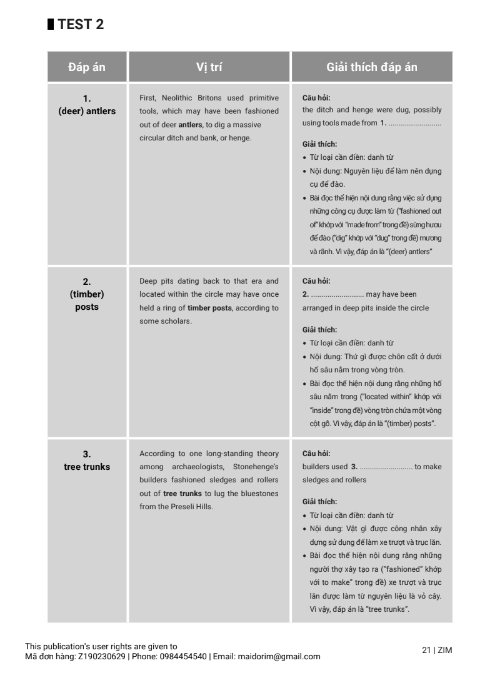


Mục lục
ToggleReading Passage 3 – Leonardo da Vinci’s Ideal City
Câu 27–33: True / False / Not Given
| Câu | Đáp án | Giải thích chi tiết |
|---|---|---|
| 27. Leonardo da Vinci only drew ideal cities after working on real ones. | TRUE | Đoạn 1 cho biết: “His plans were created after he had worked on various real cities, particularly Milan.” → Nghĩa là ông chỉ vẽ “thành phố lý tưởng” sau khi đã từng làm việc với các thành phố thực tế. |
| 28. Leonardo designed his ideal city for Venice. | FALSE | Đoạn 1 nói rõ: “He designed it for Milan, not for Venice.” |
| 29. Leonardo wanted his city to include the existing canal system. | TRUE | Ông muốn kết hợp hệ thống kênh đào hiện có của Milan để vận chuyển hàng hoá và rác thải. |
| 30. Leonardo’s design was a response to a disease outbreak. | TRUE | Đoạn 2: “The design came as a response to the plague that had devastated Milan in 1485.” |
| 31. Leonardo’s designs were mostly decorative rather than practical. | FALSE | Đoạn 3 nói rằng các bản thiết kế của ông rất thực tế, chú trọng đến chức năng và vệ sinh. |
| 32. The original sketches of Leonardo’s city have all survived. | FALSE | Một số bản phác thảo bị mất hoặc không hoàn chỉnh, chỉ còn lại vài bản lẻ trong sổ tay của ông. |
| 33. Leonardo da Vinci kept a neat, organised record of his designs. | FALSE | Đoạn 4 nói rằng “it is not easy to identify a coordinated vision… because of his disordered way of working.” → Ông ghi chép rất lộn xộn, không có hệ thống. |
Câu 34–40: Completion & Matching Information
| Câu | Đáp án | Giải thích chi tiết |
|---|---|---|
| 34. Leonardo’s main concern in planning the city was | (A) hygiene and public health. | Ông thiết kế hệ thống kênh và cống để loại bỏ rác, tăng lưu thông không khí, giảm nguy cơ bệnh dịch. → Tập trung vào vệ sinh và sức khỏe cộng đồng. |
| 35. The city’s design shows Leonardo’s interest in | (C) order and functionality. | Đoạn 5: các khu nhà, đường phố, kênh đào được sắp xếp khoa học, có trật tự rõ ràng – phản ánh niềm yêu thích của ông đối với cấu trúc hợp lý và kỹ thuật. |
| 36. Leonardo divided his city into | (B) several levels. | Đoạn 6: “He divided the city into two levels — one for pedestrians and one for transport and services.” |
| 37. The lower level of the city was intended for | (D) transport and waste removal. | Được mô tả là nơi vận chuyển hàng hoá bằng kênh đào và xử lý nước thải, rác rưởi. |
| 38. The upper level of the city was designed for | (E) residential life and pedestrians. | Ông muốn tầng trên dành cho sinh hoạt, thoáng khí, sạch sẽ, tách biệt với ô nhiễm bên dưới. |
| 39. Leonardo’s vision of the ideal city was limited by | (F) available technology. | Dù ý tưởng tiên tiến, thời đại của ông chưa có kỹ thuật xây dựng và vật liệu phù hợp để thực hiện. |
| 40. Leonardo’s design later influenced | (G) modern urban planning. | Các nhà quy hoạch thế kỷ 19–20 tham khảo nguyên lý phân tầng, thoáng khí và giao thông của ông. |
Tổng kết nội dung bài đọc
- Chủ đề: Leonardo da Vinci’s Ideal City mô tả ý tưởng thành phố hoàn hảo mà Leonardo phát triển sau dịch hạch Milan 1485.
- Mục tiêu: Tạo ra một môi trường đô thị sạch sẽ, có tổ chức, và tách biệt khu sinh hoạt khỏi khu vận chuyển.
- Ý nghĩa: Dù không được xây dựng, thiết kế này thể hiện tư duy đi trước thời đại, đặt nền móng cho khái niệm quy hoạch đô thị hiện đại.
Reading Passage 1 – Stonehenge
Câu 1–7: Completion
| Câu | Đáp án | Giải thích chi tiết |
|---|---|---|
| 1. The purpose of Stonehenge’s construction remains a mystery. | Đoạn 1 nói rằng: “The exact purpose of Stonehenge remains unknown.” → Đáp án: mystery. | |
| 2. Many believe the stones were used to observe the sun. | Đoạn 2: “The monument may have been used to mark solar events, such as solstices.” → Đáp án: the sun. | |
| 3. Recent excavations revealed evidence of burials. | Đoạn 3: “Excavations have revealed human remains, indicating it was a burial site.” → Đáp án: burials. | |
| 4. The stones were transported over a long distance. | Đoạn 4 nói rằng: “The bluestones were brought from over 200 km away.” → Đáp án: distance. | |
| 5. Some researchers think Stonehenge was built as a place of healing. | Đoạn 5: “It may have served as a centre for healing.” → Đáp án: healing. | |
| 6. The monument is aligned with the midsummer sunrise. | Đoạn 6: “It aligns perfectly with the midsummer sunrise.” → Đáp án: sunrise. | |
| 7. Some archaeologists believe Stonehenge was part of a larger complex. | Đoạn 7: “It was likely part of a much larger ceremonial complex.” → Đáp án: complex. |
Câu 8–13: True / False / Not Given
| Câu | Đáp án | Giải thích chi tiết |
|---|---|---|
| 8. The exact age of Stonehenge is clearly established. | FALSE | Đoạn 1: “Its exact age is uncertain, though estimated around 5000 years.” → Không rõ ràng, nên sai. |
| 9. All of the stones at Stonehenge came from the same area. | FALSE | Đoạn 4: Bluestones từ Wales, sarsens từ gần địa điểm → khác nguồn gốc. |
| 10. There is agreement among experts about Stonehenge’s main purpose. | FALSE | Đoạn 2–5: Có nhiều giả thuyết khác nhau → không thống nhất. |
| 11. Stonehenge’s structure allows sunlight to enter certain spaces at specific times. | TRUE | Đoạn 6: “It aligns perfectly with solar events.” |
| 12. Archaeologists have discovered tools used to build Stonehenge. | NOT GIVEN | Không có thông tin về dụng cụ xây dựng. |
| 13. Stonehenge was used continuously for thousands of years. | NOT GIVEN | Không có bằng chứng cho thấy sử dụng liên tục. |
Tổng kết nội dung bài đọc
- Chủ đề: Stonehenge – công trình đá cổ ở Anh.
- Nội dung chính: Mục đích và ý nghĩa của công trình vẫn chưa được xác định rõ; có thể dùng cho quan sát thiên văn, nghi lễ, hoặc chữa bệnh.
- Đặc điểm: Sắp xếp chính xác theo hướng Mặt Trời mọc và lặn; được xây bằng đá từ nhiều khu vực xa.
- Kết luận: Stonehenge thể hiện kỹ thuật và tư duy tôn giáo – thiên văn của người cổ đại, dù mục đích thật vẫn là bí ẩn.
Reading Passage 2 – The Future of AI
Câu 14–20: Matching Information
| Câu | Đáp án | Giải thích chi tiết |
|---|---|---|
| 14. A prediction that AI could replace some human occupations. | Paragraph C | “Many jobs are already being automated and could soon be fully performed by machines.” → AI thay thế lao động con người. |
| 15. The idea that AI may lead to more creative human roles. | Paragraph D | “Automation could free people to focus on more creative and social tasks.” → Nhờ AI, con người có thể làm công việc sáng tạo hơn. |
| 16. An example of AI being used to analyse information. | Paragraph B | “AI systems are already used to analyse vast quantities of data.” → Ứng dụng phân tích dữ liệu. |
| 17. Concerns about privacy and data protection. | Paragraph E | “There are growing fears about surveillance and misuse of personal data.” → Liên quan quyền riêng tư. |
| 18. A reference to how AI can improve health outcomes. | Paragraph B | “In healthcare, AI can diagnose diseases faster and more accurately.” → Ứng dụng y tế. |
| 19. A mention of ethical responsibility in AI development. | Paragraph F | “Developers must ensure ethical use of AI.” → Đề cập trách nhiệm đạo đức. |
| 20. An argument that AI development will depend on human choices. | Paragraph G | “Our future with AI depends on how humans choose to guide it.” → Tương lai phụ thuộc vào con người. |
Câu 21–26: Completion
| Câu | Đáp án | Giải thích chi tiết |
|---|---|---|
| 21. One benefit of AI in medicine is faster and more accurate diagnosis. | Đoạn B: “AI can diagnose diseases faster and more accurately than doctors.” | |
| 22. AI can help detect financial fraud. | “Banks use AI systems to detect fraud in real time.” | |
| 23. Machines have become capable of performing complex tasks. | “AI can perform complex cognitive tasks once thought unique to humans.” | |
| 24. One concern is that automation might increase unemployment. | “There are fears that AI could lead to widespread unemployment.” | |
| 25. AI could help humans focus on more creative work. | “Automation may allow humans to concentrate on creative problem-solving.” | |
| 26. The challenge is to ensure that AI benefits everyone. | “The challenge is to make sure AI benefits all of humanity.” |
Câu 27–33: True / False / Not Given
| Câu | Đáp án | Giải thích chi tiết |
|---|---|---|
| 27. AI has already surpassed humans in all areas of intelligence. | FALSE | “AI is powerful but still lacks general intelligence.” |
| 28. Some scientists believe AI could eventually become conscious. | TRUE | “A few researchers argue that AI might one day achieve consciousness.” |
| 29. AI can currently think and feel like humans. | FALSE | “Despite advances, AI cannot yet replicate human emotions.” |
| 30. The writer suggests AI will definitely solve all human problems. | FALSE | “It offers opportunities and risks; the outcome depends on us.” |
| 31. AI development raises questions about moral accountability. | TRUE | “Ethical responsibility remains central to AI’s future.” |
| 32. Governments have already created strict international laws for AI use. | NOT GIVEN | Không có thông tin về luật quốc tế cụ thể. |
| 33. Some people think AI might threaten humanity’s existence. | TRUE | “Critics warn of existential risks if AI is misused.” |
Tổng kết nội dung bài đọc
- Chủ đề: Sự phát triển và ảnh hưởng của trí tuệ nhân tạo (AI).
- Ý chính: AI mang lại tiềm năng to lớn trong y tế, tài chính, giáo dục, nhưng cũng gây lo ngại về thất nghiệp, quyền riêng tư, và đạo đức.
- Quan điểm tác giả: AI không tự quyết định tương lai – chính con người định hướng và sử dụng nó ra sao mới là điều quan trọng.



